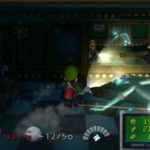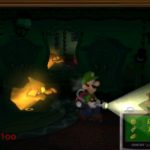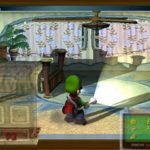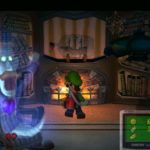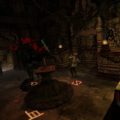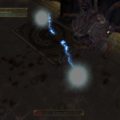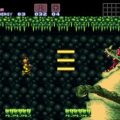Developer: Nintendo EAD Publisher: Nintendo Released: November 18, 2001 Genre: Action
In 2001 the thought of a Nintendo system launching without a Mario game was ludicrous. After all, every prior system either had a Mario title packed in or releasing alongside it to great results. Yet the GameCube did just that. Sort of. While it isn’t the Mario game everyone wanted Luigi’s Mansion turned out to be quite the pleasant surprise. In their own way Nintendo created the best Ghostbusters game on the market.
The premise of Luigi’s Mansion is pretty simple. Luigi receives a letter in the mail informing him that he has just won a mansion in a contest. Curiously he had never entered such a contest but rejoices nonetheless. Luigi agrees to inspect the mansion with Mario, who goes first. Unfortunately Mario is kidnapped by the ghosts in the mansion and it is up to Luigi, with some help from Professor E. Gadd and his Poltergust 3000, to save him.
Luigi’s Mansion was the flagship title of the GameCube launch and, next to Rogue Squadron 2, the system’s technical showcase. The lighting and shadowing effects were simply on another level next to most games on the market. The flashlight casts shadows on every object as it illuminates the environment. The flashlight’s beam kicks up dust articles and dust. The special effects don’t end there: transparency effects are used on the ghosts and advanced cloth effects are used to make the vacuum function even more realistic.
The character models are just as impressive. The best being Luigi himself. Luigi has always been a coward but Luigi’s Mansion truly sells the idea. His nervousness is instantly palpable. From his shaky knees to his constantly worried expression. He shrieks in terror and almost faints when ghosts sneak up on him. The gallery ghosts are a first class in art direction as well.
I also have to give special mention to the game’s sound design. There isn’t much music which leaves the game to rely on its sounds. And it does so in amazing fashion. Luigi nervously hums the game’s theme song to calm his nerves in quiet moments. Once you begin the capture process he gains a little courage, with the sounds he makes being particularly hilarious. The ghosts make many funny sounds but unfortunately they become repetitive.
All the graphical excess is not just for show. The primary goal in Luigi’s Mansion is capturing ghosts. The ghosts come in many shapes and flavors but they all respond to light. Once a ghost is shocked by the light their heart is exposed, making them vulnerable. Thus begins the process of capturing a ghost. But these aren’t simple fishing reel mechanics. Ghosts actively fight to run away or bump into objects as you deplete their health. The game absolutely nails this mechanic, and no matter how many times you go through it capturing always remains fun.
The game’s mechanics make capturing ghosts an easy process. Luigi’s Mansion, next to Halo and Time Splitters, showed that dual analog control was the future. Luigi has a flashlight that can be turned on and off. The Poltergust doubles as both a capturing device and a vacuum cleaner. The game’s use of both devices to interact with nearly every background object is incredibly intuitive. The ghosts are of course aware of their weakness, and actively hide in everyday appliances. Figuring out how to flush them out is half the fun. They introduce new mechanics at a decent clip too. The Poltergust gains the power of ice, fire, and water and even the Gameboy horror gains a new function or two.
Structurally the game is deceptively simple. The mansion is divided into four areas and the basement. Each area is blocked off until you meet certain conditions. While there is a large supply of regular ghosts the real targets are the 21 portrait ghosts. These ghosts in particular require different methods to capture. It isn’t always obvious how to even initiate the process but the game provides plenty of hints. Figuring out these puzzles are the absolute best parts of the game, with the solutions sometimes requiring many elaborate steps.
Some are simple. Slim Bankshot is playing billiards by himself. All you have to do is suck in the loose pool balls he shoots and attack him three times to weaken him. Then there are the clever ones. Lydia the mother ghost is an early example. Lydia completely ignores you as she combs her hair. If you look around you’ll notice the window is open. Pushing the curtains open with the vacuum will make her mad as she gets up to close the blinds. It is at this point she is vulnerable. Finally there are the complex ones. Mr. Luggs is an optional ghost. At first he ignores you. But take all his food and the waiters bringing him seconds will make him mad. After he tires himself out attacking you he finally becomes vulnerable. The game is just dripping with this kind of creativity and I love it.
There is just one problem: it’s too short. For the majority of gamers Luigi’s Mansion in less than five hours long. That is a decent length but when the game is so brilliant it is almost a crime it is over so fast. It also doesn’t help that there isn’t much replay value. Aside from the gallery ghosts there are fifty optional boos that actively wander the mansion. But aside from the thrill of tracking them down you gain nothing for capturing all of them. The cash you find throughout the game contributes to your end game score. Your score unlocks a hidden mansion which remixes the main content. It does so in come cool ways but it is still the same game.
In Closing
Luigi’s Mansion was judged harshly at the GameCube launch because it wasn’t the game we wanted. Judged on its own merits the game is fantastic however. With more content Luigi’s Mansion would have been truly incredible but is still good enough to be worth seeking out for an afternoon full of fun.


